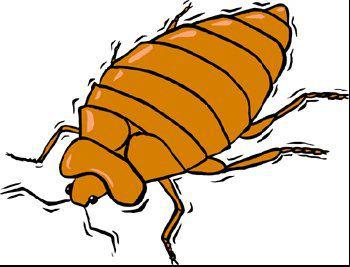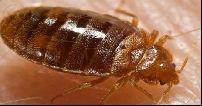Natural Solutions to Things That Bug You (66 page)
Read Natural Solutions to Things That Bug You Online
Authors: Myles Bader

DOCTORS ANSWER TO WHITEFLIES
Try using 10 tablespoons of Dr. Bronner’s Peppermint Soap™ to 1 gallon of water and add 1 tablespoon of pyrethrum and 1 tablespoon of sunflower oil to the mixture. This spray is usually only used for a serious infestation. For a minor infestation use Jungle Rain™.
Remember if you don’t control the ant population you can’t control the whiteflies since their favorite food supply comes from aphids, which are herded by ants and produce honeydew.
WHITEFLIES LOVE YELLOW
Whiteflies will damage your tomato plants unless you protect the plant. All you have to do is to place a small can (vegetable can) that has been painted yellow over the top of the stake that supports the tomato plant then place a small baggie over the can and rub Vaseline® on the baggie. This will eliminate the whitefly problem.
BIO-CONTROL TO THE RESCUE
The parasite
Encarsia formosa
will attack the larval stage of the bug and eliminate the problem. Ladybugs and lacewings find them a tempting dish to dine on.
WHOOOOOSH
If you have a portable hand vacuum it will come in handy. Just vacuum the plant and you will eliminate the whiteflies. Be sure that the vacuum is not too powerful that it will damage the plant when you try this.
COLD KILLS THEM
In the north, freezing temperatures will kill greenhouse and silverleaf whiteflies.
ISOLATION IS A MUST
Whenever you bring new plants home, be sure and quarantine them for a few weeks to be sure they are not infested.
CHAPTER 13

MISCELLANEOUS INSECT PESTS
BED BUGS

What Are Bed Bugs?
General Information:
 Bed bugs are insects of the order Hemiptera, the true bugs. Like all insects bed bugs have six legs. They are wingless insects but do develop wing pads. Bed bugs have piercing sucking mouthparts. Their needle like proboscis is inserted into the host to take a blood meal. Bed bugs feed exclusively on blood. Entomologists believe that bed bugs are evolved from nest parasites that fed on cave nesting birds and bats. When early man or hominids became cave dwellers bed bugs began to feed on man. Bed bugs develop from eggs through gradual metamorphosis where the immature bed bugs resemble the adults. The common bed bug is the most troublesome bed bug encountered within human dwellings. The scientific name of this pest is
Bed bugs are insects of the order Hemiptera, the true bugs. Like all insects bed bugs have six legs. They are wingless insects but do develop wing pads. Bed bugs have piercing sucking mouthparts. Their needle like proboscis is inserted into the host to take a blood meal. Bed bugs feed exclusively on blood. Entomologists believe that bed bugs are evolved from nest parasites that fed on cave nesting birds and bats. When early man or hominids became cave dwellers bed bugs began to feed on man. Bed bugs develop from eggs through gradual metamorphosis where the immature bed bugs resemble the adults. The common bed bug is the most troublesome bed bug encountered within human dwellings. The scientific name of this pest is
Cimex lectularius Linneaus
.
 Bed bugs do not fly and while their preferred primary hours of activity are from approximately midnight to about five in the morning, bed bugs may adapt to the hours of their host. Bed bugs do not fly and crawl from their hiding places to take a blood meal from their sleeping hosts.
Bed bugs do not fly and while their preferred primary hours of activity are from approximately midnight to about five in the morning, bed bugs may adapt to the hours of their host. Bed bugs do not fly and crawl from their hiding places to take a blood meal from their sleeping hosts.
WHERE DO BED BUGS COME FROM & HISTORY
The short answer is that bed bugs come from their parental bed bugs. However, bed bugs are transported from place to place by man and our travel habits. Bed bugs are efficient hitchhikers and are usually inadvertently picked up by people who visit places where bed bugs are.
Bed bug experts tell us that the increase in international travel these past many years has helped bed bugs cross borders and travel broadly across the globe. Business, travelers, vacation travelers, shipping, immigration and other factors have all served to facilitate the spread of bed bugs.
Bed bugs have been known as human parasites for thousands of years and over millions of years bed bugs have evolved as nest parasites living in the nests of birds and the roosts of bats.
Bed bugs, however, have learned to adapt to the human environment and live in our homes and mainly our mattresses.
Before the mid-twentieth century, bed bugs were a very common annoyance and according to a historical report by the United Kingdom, in 1933 it was thought that all the houses had some degree of bed bug infestation.
Bed bugs became a serious problem during
World War II
. In fact,
General MacArthur
made a comment that bed bugs are the "greatest nuisance insect problem at all military bases in the United States. However, with the arrival of powerful
pesticides
, especially
DDT
in the 1940s, bed bugs were almost eradicated in Western countries.
Bed bugs may have originated in the Middle East, in
caves
inhabited by
bats
and humans thousands of years ago. Bed bugs were even mentioned in ancient Greece writings as early as 400 BC and were also mentioned by
Aristotle
.
Pliny's Natural History
book that was first published around 77 AD in Rome, stated that “bed bugs had medicinal value in treating ailments” such as snake bites and ear infections.
This belief in the medicinal use of bed bugs curative properties persisted until the 18th century, when they were recommended for use in the treatment of
hysteria
. Bed bugs were also mentioned in Germany during the 11th century and in France in the 13th century.
They were mentioned in writings in England in 1583, though they remained relatively rare in England until 1670 when they became more of a pest. It was thought that in the 18th century bed bugs were brought to London with supplies of wood to rebuild the city after the
Great Fire of London
in 1666.
The traditional methods of that time to repel and/or kill bed bugs included the use of plants, fungi and insects (or their extracts), as well as
black pepper
, eucalyptus oil, henna, fly agaric, tobacco, heated oil of
turpentine
, wild mint, narrow-leaved pepperwort, bayberry, geranium, the herb and seeds of cannabis,
maple
or European cranberry bush and masked hunter bugs.
During the mid-19th century, smoke from
peat
fires was used as well as dust from grain storage. Other deterrents used for centuries included, plant ash, lime, dolomite, certain types of soil, and
diatomaceous earth
(DE), which has seen a revival as a nontoxic (when in food grade form) residual pesticide for bed bug control. Insects exposed to diatomaceous earth may take several days to die as the tiny spicules go deeper and deeper into their bodies.
One of the more interesting methods of ridding a bed of bed bugs was to place basket-work panels around beds then shaken out in the morning. This method was especially popular in the United Kingdom and France in the 19th century. Another favorite method was to scatter leaves of plants that had microscopic hooked hairs around the bed at night then sweeping them up every morning and burning them. This was also popular in southern Rhodesia and in the Balkans.
Why Are Bed Bugs a Problem Now?
By the late 1960s bed bugs were nearly eradicated from the United States. They were still here but in such low numbers that nearly no pest professionals were called about bed bugs. Veteran pest professionals report that bed bugs were rather easy to take care of years ago. This was so because there were many effective pesticides available to kill bed bugs with and the techniques used were more suited to kill bed bugs then.
Pest professionals report that calls about bed bug infestations first began in the early to mid-1990s. These calls came in from major cities and with time became more and more frequent. In subsequent years pest management professional associations have reported that the incidence of bed bugs has continued to grow each year. While bed bug calls would be viewed as uncommon by most by the year 2000, by 2010 the majority of pest control companies are fielding bed bug related calls on a regular basis.
In addition to this, while bed bugs have been in the news in the recent past the general lack of public awareness has contributed to their continued recent resurgence as a pest.
Bed Bug Development, Recognition & Identification
Bed bugs hatch from eggs and develop to adults. Bed bug eggs are oblong cylindrical shaped eggs with one end rounded and the other end with a flattened round hatch. They appear pearly white and are about one millimeter in length. The immature bed bug emerges from the round flat hatch like end which flips open when the egg hatches. This round flat cover may remain attached or may fall off during the hatching process. Once the immature bed bug has emerged from the egg the empty egg appears hollow or empty and may take on a yellowish translucent appearance.
The newly hatched immature bed bug will be a translucent yellowish in color and slightly larger than the egg it emerged from. Immature bed bugs are called instars by entomologists. Bed bugs go through five instar stages prior to becoming adults. An immature bed bug must take a blood meal in order to molt to the next instar stage of development. A freshly fed immature bed bug will take on a bright red color. As bed bugs get older they begin to take on a darker color with adults having a rusty red appearance.
Once an immature bed bug takes a blood meal it retreats back to its harborage or hiding place to digest and continue the development process. After the food resource has been sufficiently digested the immature bed bug molts into the next stage of development. As a result of the molting process the developing bed bug sheds its skin and emerges as a larger bed bug with a yellowish translucent appearance. The bed bug abdomen may contain a small dark area which is the remainder of the previous meal.